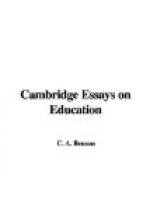The first Council under this scheme was formed in 1912 and held office for three years as prescribed by the Order in Council. The chairman was the Right Honourable A.H. Dyke Acland and the members included the Vice-Chancellors of several universities and representatives of forty-two associations of teachers. The first duty of the Council was to devise conditions of registration and these were framed during 1913, being published at the end of that year. They provide in the first place that up to the end of 1920 any teacher may be admitted to registration who produces evidence of having taught under circumstances approved by the Council for a minimum period of five years. Regard for existing interests led to the setting up of a period of grace before the full conditions of registration came into force. After 1920, however, these become more stringent and require that before being admitted to registration the teacher shall produce evidence of knowledge and experience, while all save university teachers are also required to have undertaken a course of training in teaching. Under both the temporary and later arrangement the minimum age for registration is twenty-five and the fee is a single payment of one guinea. There is no annual subscription.
The second Council was elected in 1915 and appointed as its chairman Dr Michael E. Sadler, Vice-Chancellor of the University of Leeds. Up to the middle of July, 1916, the number of teachers admitted to the Register was 17,628 and the names of these were included in the Official List of Registered Teachers issued by the Council at the beginning of 1917. The Register itself is too voluminous for publication since it comprises all the particulars which an accepted applicant has submitted. All registered teachers receive a copy of their own register entry together with a certificate of registration. It will be seen that the task of receiving and considering applications for registration forms an important part of the Council’s work. But it is by no means its chief function. As is shown in the Board of Education memorandum already quoted the Council is intended to promote the unification of the teaching profession. The Register is nothing more than the symbol of this unity and the Council is charged with the important task of expressing the views of teachers as a body on all matters concerning their work. This is shown in the speech made by the Minister of Education at the first meeting of the Council. After welcoming the members he added:
“The object of the Council would be not only the formation of a Register of Teachers. There were many other spheres and fields of usefulness for a Council representative of the Teaching Profession. He hoped that they would be able to speak with one voice as representing the Teaching Profession, and that the Board would be able to consult with them. So long as he was head of the Board they would always be most anxious to co-operate with the Council and would attach due weight to their views. He hoped that they on their side would realise some of the Board’s difficulties and that the atmosphere of friendly relationship which he trusted had already been established would continue.”




